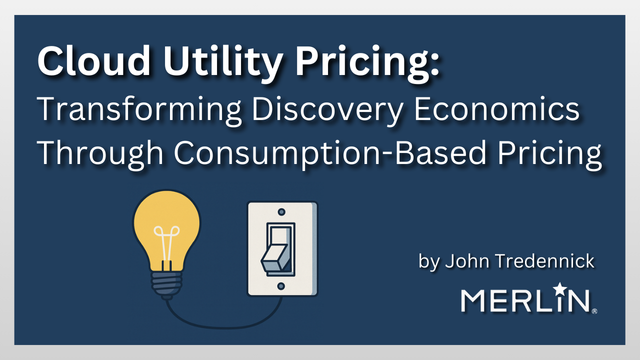
[EDRM Editor’s Note: The opinions and positions are those of John Tredennick. All images are credited to John Tredennick of Merlin Search Technologies.]
For decades, legal discovery platforms have operated on a simple but inefficient economic model: pay a fixed monthly fee per gigabyte, regardless of how much you actually use the system. This “always-on” approach treats discovery hosting like commercial real estate—you pay rent whether you’re using the space or not.
But what if discovery hosting worked more like a utility service? What if you only paid full price when the lights were on and substantially less when they weren’t needed?
This fundamental shift in thinking has led to the development of Cloud Utility Pricing—a revolutionary approach that aligns hosting costs with actual use while maintaining enterprise-grade security and instant accessibility. For general counsel managing multiple matters across extended timeframes, this innovation represents both a significant cost-reduction opportunity and a more rational way to think about discovery economics.
The Technical Foundation: Why Single-Tenant Architecture Changes Everything
To understand how Cloud Utility Pricing works, we need to examine the underlying technology that makes it possible. The key lies in what’s called single-tenant architecture—a fundamentally different approach to how discovery platforms are built and deployed.
Traditional Multi-Tenant Platforms: The Shared Infrastructure Challenge
Most discovery platforms operate on multi-tenant architecture, where multiple clients share the same underlying infrastructure, databases, and computing resources. Think of it as a large apartment building where everyone shares the same utilities, security systems, and infrastructure. While this approach can be cost-effective for vendors, it creates several limitations:

- Resource Constraints: When one client runs resource-intensive operations, it can impact performance for others sharing the same infrastructure.
- Security Risks: All client data exists within the same broader system. If security is compromised at any point, all clients are potentially exposed.
- Limited Control: Clients cannot control when the system is active or inactive because resources are shared across multiple users who may need access at different times.
- No Utility Pricing: Because the infrastructure serves multiple clients simultaneously, it must remain fully operational 24/7, making consumption-based pricing impossible.
Single-Tenant Architecture: Secure, Dedicated Cloud Environments
Single-tenant architecture takes a completely different approach. Each client’s discovery site operates in its own isolated cloud environment—essentially a private, dedicated instance that serves only that organization. This is like having your own separate building with its own utilities, security system, and infrastructure.
Each client’s discovery site operates in its own isolated cloud environment—essentially a private, dedicated instance that serves only that organization.
John Tredennick, Merlin Search Technologies.
This architectural choice creates several immediate advantages:
- Complete Isolation: Your data and processing power are entirely separate from other clients. There’s no shared infrastructure, no commingled data, and no cross-client performance impact.
- Enhanced Security: Because each environment is isolated, a security incident affecting one client cannot spread to others. Your data exists in its own secured space.
- Full Control: Since the environment is dedicated to your organization, you have complete control over when it operates. If you don’t need the system running, it can be powered down entirely.
- Dynamic Resource Scaling: The system can scale computing resources up or down based on your specific needs without affecting other clients.
The Economics of “On/Off” Technology
The single-tenant architecture creates a unique economic opportunity that’s impossible with shared infrastructure: the ability to turn sites completely on or off based on use needs.
How Traditional Hosting Works
Traditional discovery hosting operates on what we might call the “landlord model.” You pay a fixed monthly fee per gigabyte, typically ranging from $6 to $15 per GB per month, regardless of whether you access the system once or hundreds of times. The vendor maintains all infrastructure 24/7 because multiple clients share the same resources.
For a typical 1TB discovery database, this might cost $8,500 per month under traditional hosting—whether your team actively uses the system every day or it sits dormant for weeks during case lulls.
The Cloud Utility Pricing Model
Cloud Utility Pricing introduces a two-tier rate structure that reflects actual use patterns:

- Online Rate: When your site is active and accessible to users, you pay the full hourly rate. This covers the complete infrastructure needed for optimal performance.
- Offline Rate: When your site is powered down, you pay only 30% of the online rate (a 70% reduction) while maintaining full data integrity and security.
The monthly cost calculation becomes: (Online Hours × Online Rate × GBs) + (Offline Hours × Offline Rate × GBs)
Real-World Use Patterns
Understanding typical discovery use patterns reveals why this pricing model creates substantial savings. Most discovery platforms experience highly variable use:
- Active Investigation Periods: Intensive daily use during document review, depositions, and case preparation
- Dormant Periods: Extended periods when matters are on hold, settled, or in procedural phases
- Weekend and Holiday Downtime: Natural breaks when legal teams aren’t actively working
- Matter Lifecycle Variations: Cases often have peak activity followed by months of minimal access
Research indicates that typical discovery sites are actively used approximately 20% of the time over their total lifecycle. The remaining 80% represents periods when the system could be offline without impacting legal work.
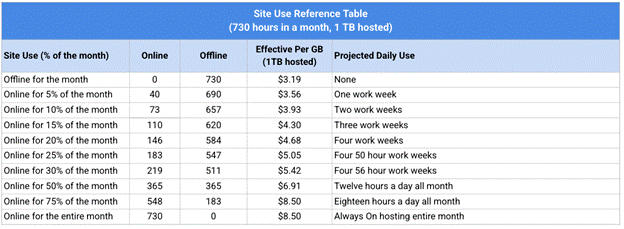
Case Study: $360,000 in Hosting Savings
A compelling example comes from a fintech company facing a government investigation. The organization was paying $35,000 monthly to host a 5TB site containing 10 million records on a traditional platform. When the investigation was put on hold pending regulatory review, the site sat completely unused for over a year while the legal team waited for the matter to resume.
Under traditional hosting, the company continued paying $35,000 monthly for a system no one accessed—a total of $420,000 over 12 months for unused capacity.
When the company moved to a platform with Cloud Utility Pricing, they simply powered down the site until needed. During the 13-month dormant period, they paid only the offline rate, spending approximately $60,000 total instead of $455,000 under traditional hosting.
Total savings: $395,000
When the investigation resumed, the site powered up in minutes with all data intact and immediately accessible. The legal team experienced no workflow disruption while saving nearly $400,000 in unnecessary hosting costs.
Technical Implementation: Three Approaches to Cost Control
Cloud Utility Pricing platforms typically offer three methods for managing site activity:
Manual Control
Legal teams can power sites on and off as needed. This approach works well for matters with predictable schedules or clear active/inactive periods. Teams simply turn on the system when beginning work and power it down at the end of each day or when entering dormant periods.
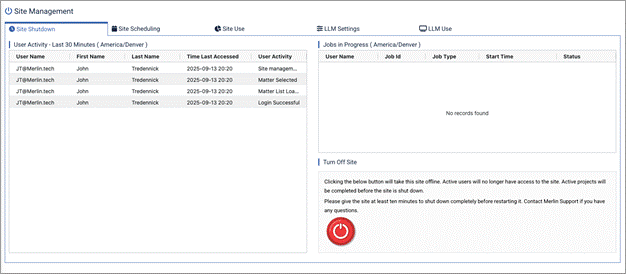
Scheduled Operations
Sites can operate on preset schedules that match team workflows. For example, automatically powering on at 7 AM and shutting down at 8 PM on weekdays, with weekend shutdowns for additional savings. After-hours access remains available—sites can power up in minutes when unexpected access is needed.
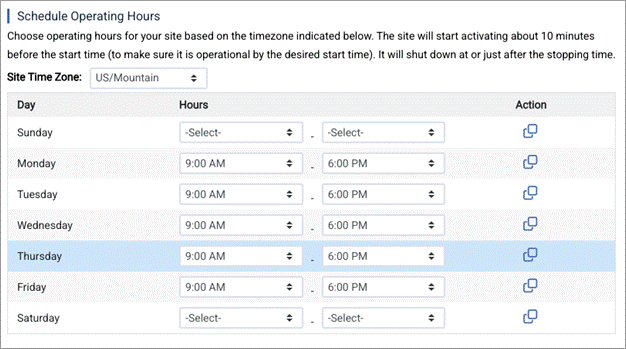
Automated Energy Management
Advanced systems can automatically transition to offline status after periods of inactivity (typically 60 minutes). This ensures optimal cost efficiency without requiring manual intervention while maintaining immediate availability when users return.
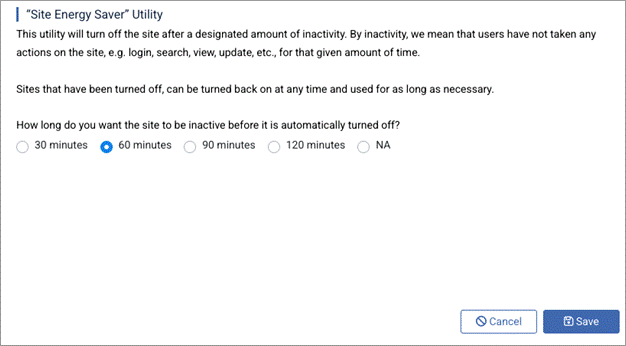
Security Advantages of Single-Tenant Architecture
Beyond cost savings, single-tenant architecture provides significant security enhancements that are particularly important for corporate legal departments handling sensitive investigations and litigation matters.
Elimination of Cross-Client Risks
Multi-tenant platforms create inherent security vulnerabilities because client data exists within shared infrastructure. A notable example occurred when a major discovery provider suffered a ransomware attack that affected all clients simultaneously. Because all client data was stored in shared repositories, hackers gained access to multiple organizations’ sensitive legal documents through a single breach point.
With single-tenant architecture, this scenario becomes impossible. Each client’s data exists in completely isolated environments with separate security controls, access points, and infrastructure. A security incident affecting one client cannot spread to others because there are no shared connection points.
Enhanced Compliance and Data Control
Corporate legal departments often face strict data residency requirements, particularly for international matters or regulated industries. Single-tenant architecture enables:
- Geographic Control: Sites can be deployed in specific jurisdictions to meet data residency requirements while maintaining isolation from other clients.
- Custom Security Protocols: Organizations can implement additional security measures specific to their compliance requirements without affecting other users.
- Audit Trail Integrity: Complete visibility into who accessed what data, when, and from where, with no risk of cross-client contamination in audit logs.
Addressing Common Concerns
“Isn’t Consumption-based Pricing More Complex Than Per-GB Pricing?”
While Cloud Utility Pricing involves two rates instead of one, the complexity is minimal and the transparency is actually greater. Traditional per-GB pricing appears simple but obscures the reality that you’re paying for infrastructure you may rarely use.
Cloud Utility Pricing provides clear visibility into actual costs based on real use. The two-rate structure directly reflects the economic reality of cloud computing: active systems require full infrastructure, while offline systems need minimal resources for data storage and security.
Most importantly, Cloud Utility Pricing is always less expensive than traditional hosting, regardless of use patterns, because the offline rate is substantially lower than any traditional per-GB rate.
John Tredennick, Merlin Search Technologies.
Most importantly, Cloud Utility Pricing is always less expensive than traditional hosting, regardless of use patterns, because the offline rate is substantially lower than any traditional per-GB rate.
“What If We Need Immediate Access?”
Single-tenant architecture enables sites to power up in minutes, not hours or days. Legal teams can access their data whenever needed without lengthy delays or complicated procedures. Many organizations find that knowing they can access their data immediately actually reduces anxiety about powering down systems during inactive periods.

Strategic Implications for Corporate Legal Departments
Cloud Utility Pricing represents more than just cost savings—it enables more strategic thinking about discovery economics and resource allocation.
Budget Predictability with Flexible Use
Rather than committing to fixed monthly costs regardless of case activity, legal departments can:
- Align costs with matter activity: Pay full rates only during active phases
- Reduce carrying costs: Minimize expenses during dormant periods without losing data access
- Optimize resource allocation: Redirect savings to other legal technology or personnel needs

Enhanced Matter Portfolio Management
For departments managing multiple concurrent matters, Cloud Utility Pricing enables more sophisticated cost management:
- Stagger matter activity: Reduce overall hosting costs by managing peak use across different cases
- Extend matter lifecycles: Keep matters accessible longer without prohibitive costs
- Support investigative workflows: Maintain access to reference materials at minimal cost
Transforming Discovery Hosting Economics
Cloud Utility Pricing represents a fundamental rethinking on how legal discovery platforms should operate and be priced. By leveraging single-tenant architecture to create true consumption-based pricing, it aligns costs with actual value delivery while enhancing security and providing greater control.
Cloud Utility Pricing represents a fundamental rethinking on how legal discovery platforms should operate and be priced.
John Tredennick, Merlin Search Technologies.
For general counsel and corporate legal departments, this innovation offers both immediate cost savings and strategic advantages. The combination of 30-60% cost reductions, enhanced security, and operational flexibility creates compelling value that traditional hosting models cannot match.
As legal technology continues evolving, innovations that deliver both economic and operational advantages will become increasingly important. Cloud Utility Pricing demonstrates how thoughtful technical architecture can create entirely new economic models that benefit legal organizations while advancing the industry toward more efficient and rational resource utilization.
The question is not whether consumption-based pricing will become standard in legal discovery—it’s how quickly legal departments will recognize its advantages and begin realizing the substantial benefits it offers.
Assisted by GAI and LLM Technologies per EDRM GAI and LLM Policy.


